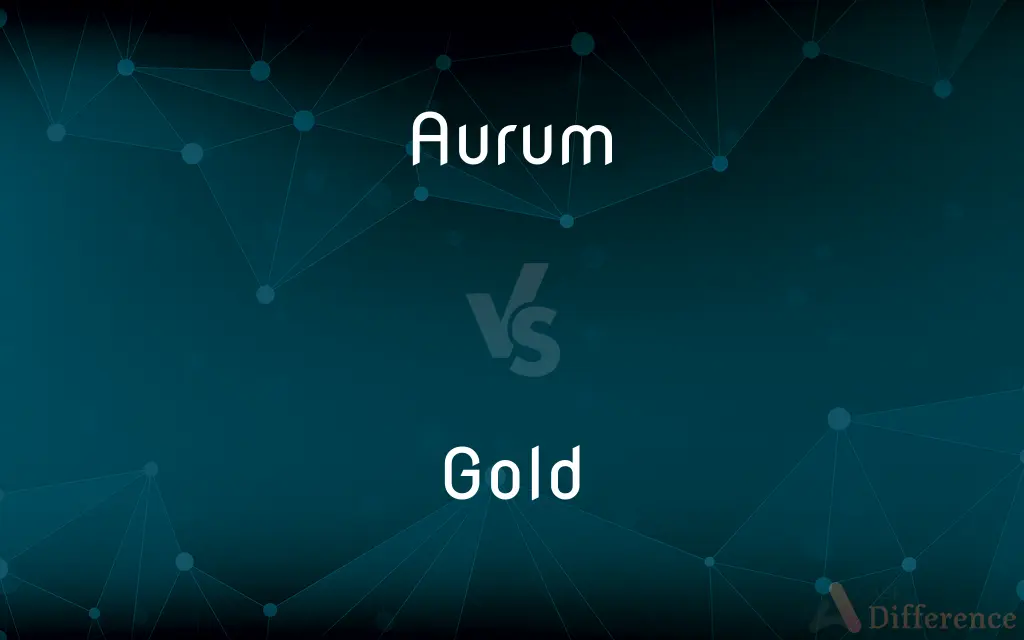Aurum vs. Gold — What's the Difference?
By Tayyaba Rehman & Maham Liaqat — Updated on April 18, 2024
Aurum is the Latin name for gold, a chemical element with the symbol Au and atomic number 79; both terms refer to the same metallic substance known for its yellow luster and high economic value.

Difference Between Aurum and Gold
Table of Contents
ADVERTISEMENT
Key Differences
While gold is the widely recognized name in modern language, particularly in science and commerce, aurum is primarily used in historical, literary, or stylistic contexts.
Gold is an element categorized under the transition metals, known for its ductility, malleability, and resistance to corrosion, whereas aurum's usage today might evoke a sense of antiquity or scholarly tone, especially in academic or poetic writing.
In the periodic table, gold is represented by the symbol 'Au', derived from aurum, highlighting the Latin origins that persist in scientific nomenclature. On the other hand, the term 'gold' is more accessible and commonly understood across various languages and cultures, reinforcing its universal appeal.
Gold’s economic and cultural significance as a symbol of wealth and status remains constant, while aurum might be preferred in contexts emphasizing traditional or classical elements.
Comparison Chart
Name Origin
Latin language
English language
ADVERTISEMENT
Usage in Text
Historical, poetic
Common, everyday use
Symbol in Science
"Au" (from Latin)
"Au"
Cultural Context
Scholarly, classical
Universal, contemporary
Appeal
Traditional, academic
Modern, widespread appeal
Compare with Definitions
Aurum
Often used in academic or poetic contexts to add a classical element.
His thesis on Roman commerce discusses the value of aurum.
Gold
A chemical element with the symbol Au and atomic number 79, known for its distinctive yellow color and luster.
Gold is highly sought after for both its aesthetic appeal and financial value.
Aurum
Sometimes employed in marketing to evoke luxury and classical beauty.
The jewelry line named 'Aurum' promises timeless elegance.
Gold
Represents wealth and prosperity in many cultures around the world.
Gold coins were once a common form of currency.
Aurum
A Latin term used historically to denote the element gold.
The ancient texts frequently reference aurum in their descriptions of wealth.
Gold
Widely used in jewelry, electronics, and as monetary security.
The necklace is made of 24-karat gold.
Aurum
Can symbolize antiquity or traditional value in literary works.
The poet spoke of aurum, aligning it with ancient virtues.
Gold
Essential in modern industries for its conductive properties.
Gold is used in almost all high-end electronic devices.
Aurum
Used in scientific contexts as the origin of the chemical symbol for gold.
Aurum is identified by the symbol 'Au' in the periodic table.
Gold
Gold is a chemical element with the symbol Au (from Latin: aurum) and atomic number 79, making it one of the higher atomic number elements that occur naturally. In a pure form, it is a bright, slightly reddish yellow, dense, soft, malleable, and ductile metal.
Aurum
(chemistry) gold, used in the names of various substances (see Derived terms) Category:en:Gold
Gold
A yellow precious metal, the chemical element of atomic number 79, used especially in jewellery and decoration and to guarantee the value of currencies.
Gold earrings
Aurum
An Italian liqueur
Gold
A deep lustrous yellow or yellow-brown colour
Her eyes were light green and flecked with gold
Aurum
Gold.
Gold
Coins or other articles made of gold
Her ankles and wrists were glinting with gold
Gold
The bullseye of an archery target.
Gold
Symbol Au A soft, yellow, corrosion-resistant element, the most malleable and ductile metal, occurring in veins and alluvial deposits and recovered by mining, panning, or sluicing. A good thermal and electrical conductor, gold is generally alloyed to increase its strength, and it is used as a common monetary standard, in jewelry, for decoration, and as a plated coating on a wide variety of electrical and mechanical components. Atomic number 79; atomic weight 196.967; melting point 1,064.2°C; boiling point 2,856.0°C; specific gravity 19.3; valence 1, 3. See Periodic Table.
Gold
Coinage made of this element.
Gold
A gold standard.
Gold
Money; riches.
Gold
A light olive-brown to dark yellow, or a moderate, strong to vivid yellow.
Gold
Something regarded as having great value or goodness
A heart of gold.
Gold
A medal made of gold awarded to one placing first in a competition, as in the Olympics
Won 9 golds in 13 events.
Gold
Having the color of gold.
Gold
(uncountable) A heavy yellow elemental metal of great value, with atomic number 79 and symbol Au.
Gold
A coin or coinage made of this material, or supposedly so.
The pirates were searching for gold.
Gold
(uncountable) A deep yellow colour, resembling the metal gold.
Gold
(countable) The bullseye of an archery target.
Daniel hit the gold to win the contest.
Gold
(countable) A gold medal.
France has won three golds and five silvers.
Gold
(figuratively) Anything or anyone that is very valuable.
That food mixer you gave me is absolute gold, mate!
Gold
A grill jewellery worn on front teeth made of gold.
Gold
Made of gold.
A gold chain
Gold
Having gold of gold.
Gold sticker
Gold socks
Gold
(of commercial services) Premium, superior.
Gold
Of a musical recording: having sold 500,000 copies.
Gold
In a finished state, ready for manufacturing.
Gold
To appear or cause to appear golden.
Gold
Of or referring to a gold version of something
Gold
An old English name of some yellow flower, - the marigold (Calendula), according to Dr. Prior, but in Chaucer perhaps the turnsole.
Gold
A metallic element of atomic number 79, constituting the most precious metal used as a common commercial medium of exchange. It has a characteristic yellow color, is one of the heaviest substances known (specific gravity 19.32), is soft, and very malleable and ductile. It is quite unalterable by heat (melting point 1064.4° C), moisture, and most corrosive agents, and therefore well suited for its use in coin and jewelry. Symbol Au (Aurum). Atomic weight 196.97.
Gold
Money; riches; wealth.
For me, the gold of France did not seduce.
Gold
A yellow color, like that of the metal; as, a flower tipped with gold.
Gold
Figuratively, something precious or pure; as, hearts of gold.
Gold
Coins made of gold
Gold
A deep yellow color;
An amber light illuminated the room
He admired the gold of her hair
Gold
A soft yellow malleable ductile (trivalent and univalent) metallic element; occurs mainly as nuggets in rocks and alluvial deposits; does not react with most chemicals but is attacked by chlorine and aqua regia
Gold
Great wealth;
Whilst that for which all virtue now is sold, and almost every vice--almighty gold
Gold
Something likened to the metal in brightness or preciousness or superiority etc.;
The child was as good as gold
She has a heart of gold
Gold
Made from or covered with gold;
Gold coins
The gold dome of the Capitol
The golden calf
Gilded icons
Gold
Having the deep slightly brownish color of gold;
Long aureate (or golden) hair
A gold carpet
Common Curiosities
What role does gold play in the global economy?
Gold plays a critical role in the global economy as a stable investment option and reserve asset for central banks.
What are the main uses of gold in everyday life?
Gold is primarily used in jewelry, investment, and industrial applications such as electronics and dentistry.
Why might someone choose to use the term aurum instead of gold in writing?
Someone might choose "aurum" over "gold" to lend an air of antiquity, formality, or scholarly appeal to their writing.
What is the difference in the visual representation of aurum and gold?
There is no visual difference; aurum and gold refer to the same element, typically seen as a shiny, yellow metal.
How does the historical significance of aurum differ from gold?
The historical significance of aurum and gold is the same, but the term "aurum" specifically evokes the historical and classical use of gold in ancient Roman and medieval times.
What is aurum used for in modern language?
Aurum is mainly used in historical, academic, or poetic contexts to invoke a classical or traditional essence.
How do aurum and gold relate in terms of chemical composition?
Aurum and gold are the same substance; aurum is simply the Latin name for the element gold.
Is aurum considered a precious metal?
Yes, aurum, known as gold in modern terminology, is considered a precious metal due to its rare and valuable nature.
Why is gold valuable?
Gold is valuable due to its rarity, aesthetic appeal, and practical applications in various industries, including jewelry and electronics.
Can aurum be considered a modern term?
No, aurum is not considered a modern term; it is mainly used in historical or classical contexts, whereas "gold" is the contemporary term.
What cultural symbolism is associated with gold across different societies?
Gold is universally symbolic of wealth, purity, and achievement, and is often associated with divine or royal status in various cultures.
What is the origin of the symbol 'Au' for gold?
The symbol 'Au' comes from the Latin word 'aurum', used in ancient times to refer to gold.
How are the physical properties of gold advantageous in technology?
Gold's excellent conductivity, corrosion resistance, and malleability make it ideal for use in high-end electronics and connectors.
How does the rarity of gold affect its value?
The rarity of gold significantly contributes to its high value, as it is both less common and highly in demand for various uses.
Can the terms aurum and gold be used interchangeably?
While they can be technically interchangeable as they refer to the same element, 'gold' is preferable in common usage and 'aurum' in more scholarly or traditional contexts.
Share Your Discovery

Previous Comparison
Bid vs. Bit
Next Comparison
Season vs. SeasoningAuthor Spotlight
Written by
Tayyaba RehmanTayyaba Rehman is a distinguished writer, currently serving as a primary contributor to askdifference.com. As a researcher in semantics and etymology, Tayyaba's passion for the complexity of languages and their distinctions has found a perfect home on the platform. Tayyaba delves into the intricacies of language, distinguishing between commonly confused words and phrases, thereby providing clarity for readers worldwide.
Co-written by
Maham Liaqat













































